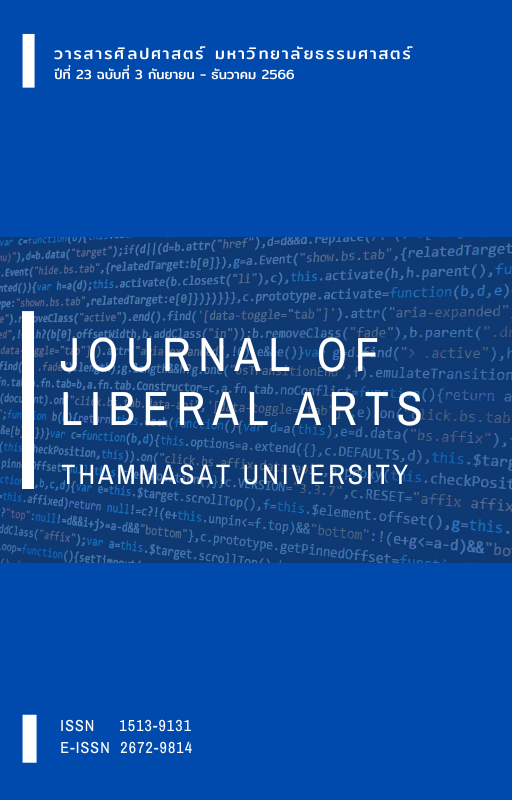การศึกษาเปรียบเทียบประสิทธิภาพของสิ่งกระตุ้นทางสายตาในการออกเสียงประโยคคำถามภาษาอังกฤษของผู้เรียนชาวไทย
Main Article Content
บทคัดย่อ
การวิจัยครั้งนี้มีวัตถุประสงค์เพื่อศึกษาว่าการใช้สิ่งกระตุ้นทางสายตา (visual cue) ในแบบที่ 1 คือ แบบมีตัวเลข ในแบบที่ 2 คือ แบบไม่มีตัวเลขและการไม่ใช้สิ่งกระตุ้นทางสายตา มีความแตกต่างต่อการช่วยให้ผู้เรียนชาวไทยสามารถออกเสียงประโยคคำถามตอบรับและปฏิเสธ (Yes/No question) และประโยคคำถามตอบแสดงเนื้อความ (WH question) ในภาษาอังกฤษได้ใกล้เคียงกับเจ้าของภาษาหรือไม่ กลุ่มตัวอย่างที่ใช้คือ นิสิตสาขาภาษาอังกฤษ ชั้นปีที่ 1 คณะมนุษยศาสตร์ ในมหาวิทยาลัยแห่งหนึ่ง จำนวน 30 คน ประโยคที่ใช้ในการทดสอบคือ ประโยคคำถามตอบรับและปฏิเสธ และประโยคคำถามตอบแสดงเนื้อความ รวมทั้งหมด 30 ประโยค การทดสอบ ผู้เข้าร่วมการทดลองได้ทดสอบการพูด แบ่งกลุ่มออกเป็น 3 กลุ่ม กลุ่มละ 10 คน ในแต่ละกลุ่มจะได้รับการทดสอบการพูดที่แตกต่างกัน คือ การทดสอบโดยใช้สิ่งกระตุ้นทางสายตาแบบมีตัวเลขกับแบบไม่มีตัวเลข และไม่ใช้สิ่งกระตุ้นทางสายตา วิเคราะห์ข้อมูลด้วยการหาค่าเฮิรตซ์ (Hertz) ในโปรแกรม Praat แปลงค่าเซมิโทน (semitone) และใช้สูตรหาค่าระยะทางแบบยุคลิด (Euclidean distance) เพื่อหาค่าระยะห่างทั้ง 11 จุด ผลการวิจัยพบว่า การทดสอบโดยใช้สิ่งกระตุ้นทางสายตาแบบมีตัวเลข สามารถช่วยให้ผู้เรียนชาวไทยสามารถออกเสียงประโยคคำถามตอบรับและปฏิเสธ และประโยคคำถามตอบแสดงเนื้อความในภาษาอังกฤษได้ใกล้เคียงกับเจ้าของภาษามากที่สุด
Downloads
Article Details

อนุญาตภายใต้เงื่อนไข Creative Commons Attribution-NonCommercial-NoDerivatives 4.0 International License.
เอกสารอ้างอิง
ปัญณิตา ชัยสนิท. (2548). การพูดเพื่อการประชาสัมพันธ์ (พิมพ์ครั้งที่ 1). มหาวิทยาลัยราชภัฏ อุตรดิตถ์, คณะวิทยาการจัดการ.
ศันสนะ มูลทาดี, ทวีศักดิ์ ขันยศ, และ ชนม์ชกรณ์ วรอินทร์. (2559). การพัฒนาทักษะการพูดภาษาอังกฤษของนักเรียนชั้นมัธยมศึกษาปีที่ 5 ด้วยวิธีแสดงบทบาทสมมติ. วารสารมนุษยศาสตร์และสังคมศาสตร์ บัณฑิตวิทยาลัย มหาวิทยาลัยราชภัฏพิบูลสงคราม, 10(1), 68-83.
‘t Hart, J., Collier, R., & Cohen, A. (1990). A perceptual study of intonation: An experimental- phonetic approach. Cambridge University Press.
Abu-Snoubar, T. K. (2017). On The Relationship between listening and speaking grades of AL-Balqa applied university English as a foreign language students. International Education Studies, 12(10), 130-139.
Arias, J. P., Yoma, N. B., & Vivanco, H. (2009). Automatic intonation assessment for computer aided language learning. Speech Communication, 52(3), 254-267. https://doi.org/10.1016/j.specom.2009.11.001
Bot, D. K. (1983). Visual Feedback of Intonation I: Effectiveness and Induced Practice Behavior. Language and Speech, 6(4), 331-349.
Council of Europe. (2020). Common European framework of reference for languages: Learning, teaching, assessment - Companion volume. Council of Europe Publishing, Strasbourg.
Delongová, M. (2013). Intonation Patterns Expressing Politeness in English Requests and Commands and Their Cross-language Perception. [Doctoral dissertation]. Palacký University. https://theses.cz/id/wfk7jl/00177441-225834519.pdf
English Profile. (2013). Vocabulary Word Lists According to the CEFR. https://www.toe.gr/course/view.php?id=27
Exam English Ltd. (2019). CEFR Levels. https://www. examenglish.com/CEFR/cefr.php
Gerard, W. G. S., & Dik, J. H. (2014). A Visual Display for the Teaching of Intonation. CALICO Journal, 10(3), 19-30.
Gohil, P. P. (2013). English as a Global Language. International Journal for Research in Education, 2(2), 1-13.
Han, J. I., & Kang, H. (2013). Cross-generational change of /o/ and /u/ in Seoul Korean I: Proximity in vowel space. Phonetics and Speech Sciences (말소리와 음성과학), 5(2), 25-31. https://doi.org/10.13064/KSSS.2013.5.2.025
Harmer, J. (2007). The Practice of English Language Teaching. Harlow, Pearson Education Limited.
Hedberg, N., & Sosa, M. J. (2002). The Prosody of Questions in Natural Discourse. http://www.sfu.ca/~hedberg/HedbergSosa_final.pdf
Ke, D., & Xu, B. (2009). Chinese intonation assessment using SEV features. In IEEE International Conference on Acoustics, Speech and Signal Processing (pp. 4853-4856). https://doi.org/10.1109/ICASSP.2009.4960718
Ladd, R. (2008). Intonation Phonology. (2nd ed.). Cambridge University Press.
Luo, H., Koszalka, T., & Zuo, M. (2016). Investigating the effects of visual cues in multimedia instruction using eye tracking. In S. Cheung, Lf. Kwok, J. Shang, A. Wang, R. Kwan (Eds.), Blended Learning: Aligning Theory with Practices (pp. 63-72). Springer, Cham. https://doi.org/10.1007/978-3-319-41165-1_6
Neumeyer, V., Harrington, J., & Draxler, C. (2010). An acoustic analysis of the vowel space in young and old cochlear-implant speakers. Clinical Linguistics & Phonetics, 24(9). https://doi.org/10.3109/02699206.2010.491173
Nolan, F. (2003). Intonational equivalence: An experimental evaluation of pitch scales. In M. J. Solé, D. Recasens, & J. Romero (Eds.), Proceedings of the 15th International Congress of Phonetic Sciences (pp. 771-774). http://www.internationalphoneticassociation.org/icphs/icphs2003
Orion, F. G. (1997). Pronouncing American English Sounds, Stress, and Intonation (2nd ed.). Heinle ELT.
Oxford Placement Test. (2021). Listening Level Test. https://www.oxfordonlineenglish.com/english-level-test/listening
Pierrehumbert, J. (1980). The Phonology and Phonetics of English Intonation [Doctoral dissertation, Massachusetts Institute of Technology]. http://dspace.mit.edu/handle/1721.1/16065
Roach, P. (1943). English Phonetics and Phonology: A Practical Course. (22nd ed.). Cambridge University Press.
Silverman, K., Beckman, M., Pitrelli, J., Ostendorf, M., Wightman, C., Price, P., Pierrehumbert, J., & Hirschberg, J. (1992). TOBI: a Standard for Labeling English Prosody. In Proceedings of the 1992 International Conference on Spoken Language Processing (PLACE) (pp. 867-870). https://www.isca-speech.org/archive/icslp_1992/index.html
Taylor, D. S. (1993). Intonation and Accent in English: What Teachers Need to Know. International Review of Applied Linguistics in Language Teaching, 31, 1-21.
Tran, M. (2020). Daily English Conversation Practice. https://basicenglish speaking.com/daily-english-conversation-topics/
Wei, Y. F., & Zhou, Y. L. (2002, April 6). Insights into English Pronunciation Problems of Thai Students [Paper presentation]. The Annual Meeting of the Quadruple Helix.
Yangklang, W. (2013). Improving English stress and intonation pronunciation of the first year students of Nakhon Ratchasima Rajabhat University. Procedia Social and Behavioral Sciences, 91(3), 444-452. https://doi.org/10.1016/j.sbspro.2013.08.442
Zhao, S., Luke, K. K., Koh, S. N., & Zhang, Y. (2010). Computer Aided Evaluation of Intonation for Language Learning Based on Prosodic Unit Segmentation. Proceedings of the Second APSIPA Annual Summit and Conference, 788-793. http://www.apsipa.org/proceedings_2010/pdf/APSIPA157.pdf


